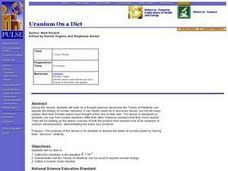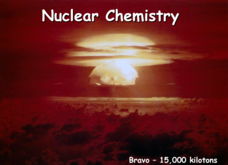Curated OER
Units in Thermochemical Calculations
Students study how to complete thermochemical equations. In this equation lesson students learn how to manipulate equations to calculate energy changes and reactions.
Curated OER
Acid and Base Worksheet
In this acids and bases learning exercise, learners apply the Bronsted-Lowry theory of acids and bases to write the products for the given acid-base reactions. This learning exercise has 7 problems to solve.
Curated OER
Don’t be a Stoic about Stoichiometry
Students review balancing chemical equations. In this chemistry lesson plan, students calculate moles of an unknown substance based on stoichiometric relationships in the balanced equation. They cite applications of stoichiometry in...
Curated OER
The Chemistry of Coal
Students investigate the chemistry of coal. This lesson serves as a review of conservation of mass, simple reactions and equation balancing. During the lesson, students research chemical components of coal, as well as environmental...
Curated OER
A Solution for Precipitation
Students predict the product of chemical reaction using the solubility rules. In this chemistry lesson, students balance ionic equation. They perform a lab to check if their predicted products are correct.
Curated OER
Rusting: A Form of Oxidation
Students observe and record the corrosive nature of oxidation-reduction reactions, and determine the electro-chemical series of selected metals.
Curated OER
Uranium On a Diet
Pupils examine how nuclear reactions differ from other chemical reactions they have studied. They add up atomic masses of both the product and reactant side of an example of uranium decomposition, demonstrating mass loss involved.
Curated OER
Production of Hydrogen
Students generate hydrogen gas and examine some of its properities through an experiment. In the experiment, a wood splint is lit along with a candle, then the reaction occurs within the mixture. There are questions for the student to...
Curated OER
Physical and Chemical Changes
Eighth graders distinguish between physical and chemical change. In this chemistry lesson, 8th graders observe a series of demonstrations showing physical and chemical changes. They identify the signs that a chemical reaction took place.
Curated OER
Water Quality
In this water worksheet, students determine the factors that effect the solubility of gases, calculate the percent concentration of solutions, and give the balanced chemical equation for photosynthesis. This worksheet has 18 short answer...
Curated OER
Where My Peeps At?
Students conduct a series of activity that demonstrates Charles' and Boyle's Law. In this chemistry lesson plan, students determine the relationship among pressure, volume and temperature. They solve problems using mathematical...
Curated OER
Composition of Fuels -- Chemical Models Investigation
Students construct models of alternative fuel molecules and record their molecular formulas. They participate in a lab activity in which they demonstrate the chemical reactions that take place. They balance chemical equations.
Curated OER
Oxidation-Reduction and Electrochemistry
Young scholars are introduced to the topics of oxidation reduction and electrochemistry. Using this information, they review how to balance equations and solve half-reaction problems. In groups, they complete a lab activity and identify...
Curated OER
The Football and Braking Distance: Model Data with Quadratic Functions
Students engage in a lesson that is about the concept of data analysis with the use of quadratics. They use a Precalculus text in order to give guidance for independent practice and to serve as a source for the teacher to use. The data...
Virginia Department of Education
Properties of Compounds and Chemical Formulas
Young chemists have unknown compounds they need to sort. Performing three different tests on each, the chemical behaviors they observe become the basis for data analysis.
Curated OER
Enzymes Help Us Digest Food ~ Introduction to Sugars and Enzymes
After an explanatory introduction to sugars and enzyme activity, biochemists discover whether lactase is needed to digest lactose, sucrose, and milk as a whole. High school science lab skills are required for these investigations.
Virginia Department of Education
Equilibrium and Le Chatelier’s Principle
The best part of learning about equilibrium is that nothing changes. Young chemists observe four demonstrations during this lesson: equilibrium in a saturated solution, equilibrium with an acid-base indicator, equilibrium with cobalt...
Curated OER
Stoichiometry, Percent Yield and Limiting Reagents: practice problems
The questions here present situational problems and calculations to help your students understand the application of the math and data analysis practice.
Curated OER
Chapter 14 Review, Section 2: Acids and Bases
Lewis acids and bases, Brønsted-Lowry acids and bases, ionization, and more are covered by this chemistry handout. It serves as a review of a specific textbook section, but will also serve as a nice review for any general chemistry...
Curated OER
Kinetics of acetone iodination
In this chemistry worksheet, students examine the given concept in order to apply in the laboratory setting. The sheet includes in depth background information.
Virginia Department of Education
Soap, Slime, and Creative Chromatography
Do you think chromatography paper suffers from separation anxiety? Young chemists make soap, slime, silly putty, and experiment with chromatography in this lesson. The material includes clear instructions for each experiment along with...
Curated OER
Determination of the solubility product of silver(I) chloride
In this chemistry worksheet, students examine the concept of solubility of silver chloride. The sheet has in depth concept and laboratory instructions.
Curated OER
Organic Chemistry II
In this chemistry worksheet, students write the structures for the compounds illustrated on the sheet. Then they name the compounds whose structures are illustrated in part two. Students also fill in the blanks to complete the paragraph...
Science Geek
Nuclear Chemistry
Which bichemicals wash up on shore? Nucleotides! Presentation covers alpha, beta, and gamma radiation. Includes a comparison of fission versus fusion. Presentation is the second in a five-part series.























